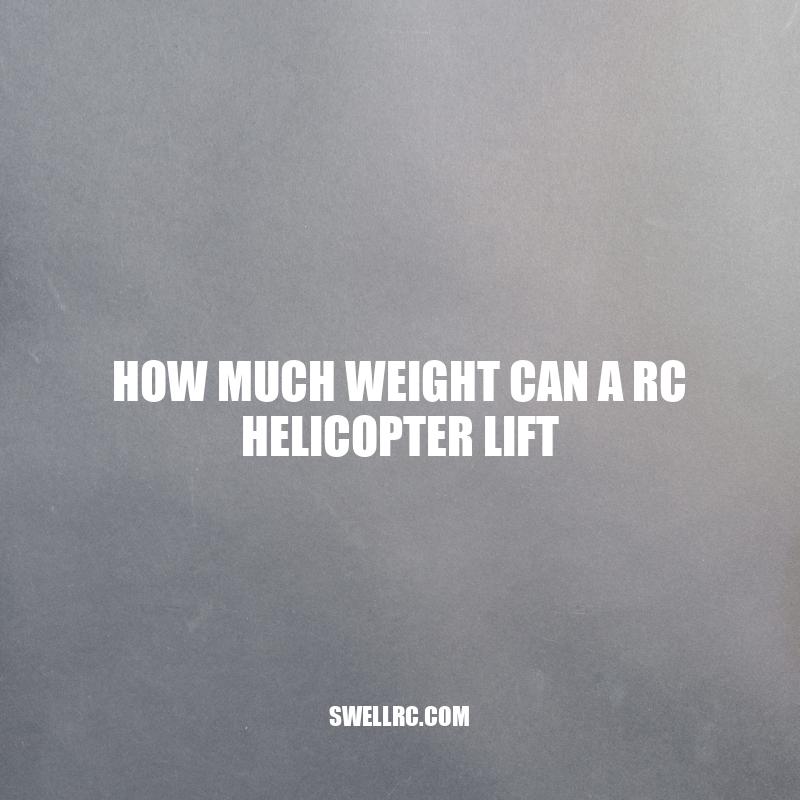RC Helicopter Lifting Capacity: How Much Weight Can They Really Handle?
Remote-controlled (RC) helicopters have been increasing in popularity in recent years, attracting hobbyists of all ages. These miniature flying machines are fascinating to watch as they hover, maneuver, and perform daring acrobatics. But for some enthusiasts, flying an RC helicopter is not enough – they want to see how much weight these tiny aircraft are capable of lifting. Knowing the lifting capacity of an RC helicopter is important for those who want to experiment with aerial photography, transport small objects, or just show off their skills. In this article, we will explore the factors that affect an RC helicopter’s lifting capacity, the basic rule of thumb for determining the amount of weight it can lift, examples of different types of helicopters and their lifting capacities, and safety considerations for those attempting to lift weights with an RC helicopter. Whether you’re a seasoned RC pilot or a curious newbie, continue reading to learn more about the fascinating world of RC helicopter lifting.
Factors Affecting Lift
There are several factors that can impact the lifting ability of an RC helicopter. Some of the most significant factors include:
- The size and power of the helicopter’s motor
- The helicopter’s weight and size
- The size and design of the helicopter’s rotors, including the number of blades and their angle of attack
- The wind speed and direction
- The weight and distribution of the object being lifted
All of these factors work together to determine the amount of weight an RC helicopter can lift. In general, the larger and more powerful the helicopter is, the more weight it is capable of lifting. However, there is a limit to how much weight any given helicopter can lift, so it’s important to understand the basic rule of thumb used by most RC enthusiasts when determining lifting capacity. For more detailed information on each of these factors and how they impact lifting capacity, consult the manufacturer’s specifications for your RC helicopter or visit RC hobbyist forums for advice and tips.
How much weight can a helicopter carry?
- The weight a helicopter can carry depends on its size, power, and rotor system.
- Small helicopters can carry up to 500 pounds, while larger ones can carry up to several thousand pounds.
- The maximum weight a helicopter can carry is determined by its maximum takeoff weight (MTOW).
For more information about helicopters and their capabilities, you can visit aviation websites such as FAA or AircraftCompare.
Basic Rule of Thumb
When it comes to determining the lifting capacity of an RC helicopter, most hobbyists follow a basic rule of thumb: the helicopter should be able to lift at least twice its own weight. This means that if a helicopter weighs 1 pound, it should be able to lift at least 2 pounds of additional weight. However, it’s important to keep in mind that this is just a general guideline and may not apply to all RC helicopters.
Lifting Capacity Examples
Here are some lifting capacity examples of different types of RC helicopters:
| Helicopter Type | Lifting Capacity |
|---|---|
| Micro/Mini Helicopter | 2 to 3 ounces |
| Small RC Helicopter | 8 to 10 ounces |
| Large RC Helicopter | Several pounds |
These are just general lifting capacities, and may vary depending on the specific make and model of your RC helicopter. It’s important to consult the manufacturer’s specifications before attempting to lift any significant amount of weight with your RC helicopter.
What is the carrying capacity of a helicopter?
The carrying capacity of a helicopter depends on various factors that include its type, size, weight, and design. Here are some general guidelines:
- Lightweight helicopters can carry up to 2-3 passengers.
- Medium-sized helicopters can carry up to 6-10 passengers.
- Heavy-lift helicopters can carry up to 20,000 pounds of weight.
It’s important to note that the carrying capacity also depends on the altitude, temperature, and other factors that affect a helicopter’s performance. If you’re planning to charter a helicopter, make sure to check with the helicopter operator about their specific carrying capacity and restrictions.
If you’re interested in learning more about helicopter capabilities and usage, check out the websites of helicopter manufacturers like Airbus Helicopters or Bell Helicopter.
Lifting Capacity Examples
As mentioned earlier, the DJI Phantom 4 is one of the most popular professional-level RC helicopters on the market. It is capable of lifting up to 3.3 pounds of weight with ease, making it perfect for aerial photography and videography.
The Blade mSR X is a popular beginner-level RC helicopter. It has a lifting capacity of up to 0.5 ounces and can be used for indoor or outdoor flying.
The WLtoys V913 is a large, powerful RC helicopter that is capable of lifting up to 2.2 pounds of weight. It features a 4-channel remote control and is suitable for both beginner and advanced pilots.
The Hubsan X4 H107D+ is a mini RC drone with a lifting capacity of up to 1.6 ounces. It features a 720p HD camera and is a popular choice for those interested in aerial photography and videography.
It’s important to keep in mind that these lifting capacities are based on each helicopter’s specifications and abilities. It’s always recommended to consult the manufacturer’s specifications before attempting to lift any significant amount of weight with your RC helicopter.
How do you calculate maximum lifting capacity?
To calculate the maximum lifting capacity of a crane, the following factors need to be considered:
- Crane model and specifications
- Boom length and type
- Jib length and type (if applicable)
- Counterweight size (if applicable)
- Load weight and location
Once these factors are determined, a load chart specific to the crane can be consulted to determine the maximum lifting capacity at the desired boom length and jib length (if applicable).
Various websites offer load chart calculators for specific crane models, such as Cranepedia.com and Manitowoc.com. It is important to note that the lifting capacity may vary depending on the specific configuration and conditions of the crane and load.
Weight vs. Flight Time
It’s important to remember that the weight an RC helicopter can lift is directly related to its flight time. Here are some things to keep in mind when trying to lift heavy objects with your RC helicopter:
- Every additional ounce of weight requires more power from the helicopter’s motor, which can decrease the amount of time it can stay in the air.
- Make sure you take into account the weight of the object being lifted as well as the weight of any additional equipment like cameras or sensors.
- Be mindful of the battery life of your helicopter – the heavier the object being lifted, the shorter the overall flight time will be.
- Consider upgrading to a higher-powered battery or purchasing spare batteries to extend your helicopter’s flight time.
By keeping these factors in mind, you can ensure that your RC helicopter is able to safely and efficiently lift the amount of weight you need it to, while also maximizing its overall flight time.
How does weight affect a helicopter?
- The weight of a helicopter is a crucial factor in its performance and maneuverability.
- Exceeding the recommended weight can compromise the helicopter’s ability to lift off, hover, and fly quickly and safely.
- The weight of the passengers, cargo, and fuel must be carefully calculated before takeoff.
- Helicopter pilots also consider the density altitude, temperature, and wind conditions to adjust for the weight and its impact on the aircraft’s performance.
Visit www.faa.gov for more information on helicopter weight limitations and regulations.
Safety Considerations
Before attempting to lift any significant weight with your RC helicopter, it’s important to keep some safety considerations in mind. Here are a few things to consider:
- Always balance the weight being lifted to ensure that the helicopter remains stable in flight.
- Secure the weight being lifted with a harness or other device to prevent it from falling and causing injury or damage.
- Avoid flying your helicopter near people or animals while lifting weights to prevent accidents.
- Be aware of your helicopter’s limitations and do not attempt to lift more weight than it can handle.
Additionally, it’s important to always follow the manufacturer’s instructions and safety guidelines when operating your RC helicopter. By taking these safety precautions, you can ensure that you and those around you stay safe while using your RC helicopter for lifting purposes.
What are the safety considerations?
When it comes to any product or website, safety is always a concern. Here are some important considerations to keep in mind:
- Make sure the website or product is legitimate and trustworthy.
- Check for any potential risks, such as scams or viruses.
- If purchasing a product, read and follow all safety instructions and warnings.
- Be cautious when sharing personal information online, such as your address or credit card information.
- If unsure or concerned about safety, consult with a professional or trusted source.
Remember, taking precautions and being informed can help ensure a safe and positive experience with any website or product.
Conclusion
In conclusion, the amount of weight an RC helicopter can lift depends on several factors, such as the size and power of the motor, the weight of the helicopter itself, and the size and design of the rotors. While there is a basic rule of thumb that states an RC helicopter should be able to lift at least twice its own weight, the lifting capacity can vary greatly between different models. When attempting to lift weights with an RC helicopter, it’s important to keep safety considerations in mind, such as carefully balancing and securing the weight being lifted, and avoiding flying near people or animals. Always follow the manufacturer’s instructions and safety guidelines when operating your RC helicopter to ensure safe and successful lifting.



